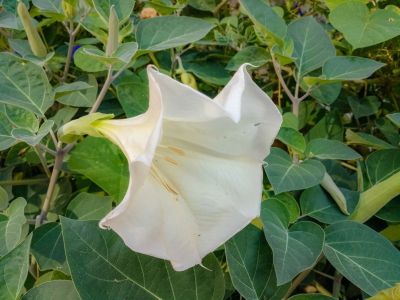What is Datura?
Datura plants are often confused with Brugmansia. Brugmansia or Datura, which is which? Brugmansia can become a massive woody tree but Datura is smaller and less woody with upright as opposed to drooping flowers. Trumpet flower has a bad rap due to a history that links it to such dangerous plants as nightshade and mandrake. Let’s set that aside and look at its attributes. Datura plants grow quickly and may get up to 4 feet (1 m.) tall. The blooms are fragrant and particularly so at night. Most flowers are white but they may also be yellow, purple, lavender and red. Stems are soft, but erect, and they have a grayish green tinge. Leaves are lobed and lightly furred. The flowers are the standout at several inches (9 cm.) in width. The plant is generally an annual but self seeds vigorously and seedlings grow at a furious rate to adult plants in one season. This self-seeding behavior ensures Datura plant growing year after year.
How to Grow Datura Trumpet Flower
Datura plants are ridiculously easy to grow from seed. They need full sun and rich fertile earth that drains well. Sow seeds directly outside into a prepared bed in fall in warmer climates and in early spring after all danger of frost has passed in cooler climates. You can grow trumpet flower inside or outside in a pot, or simply spread seed with a light coat of sand outside in a sunny location. The little plants will exceed your expectations with their speedy growth and low maintenance.
Datura Trumpet Flower Care
Datura plants need full sun, fertile soil and regular watering. They get droopy and cranky if they do not get adequate moisture. During winter they can sustain themselves in most climates with whatever moisture naturally occurs. Datura trumpet care specifies that potted plants need special care and annual repotting. The plants may lose leaves in winter if left outside in milder climates, but spring back in warmer temperatures. Datura plants growing in colder zones will require you to move the plant indoors or just let it reseed and start new plants. Fertilize in spring with a light flowering plant food high in nitrogen and then follow with a formula higher in phosphorus to promote flowering. Cut back errant stems, but otherwise you don’t need to prune this plant. Staking may be necessary when the plant grows too quickly and has slender stems.
